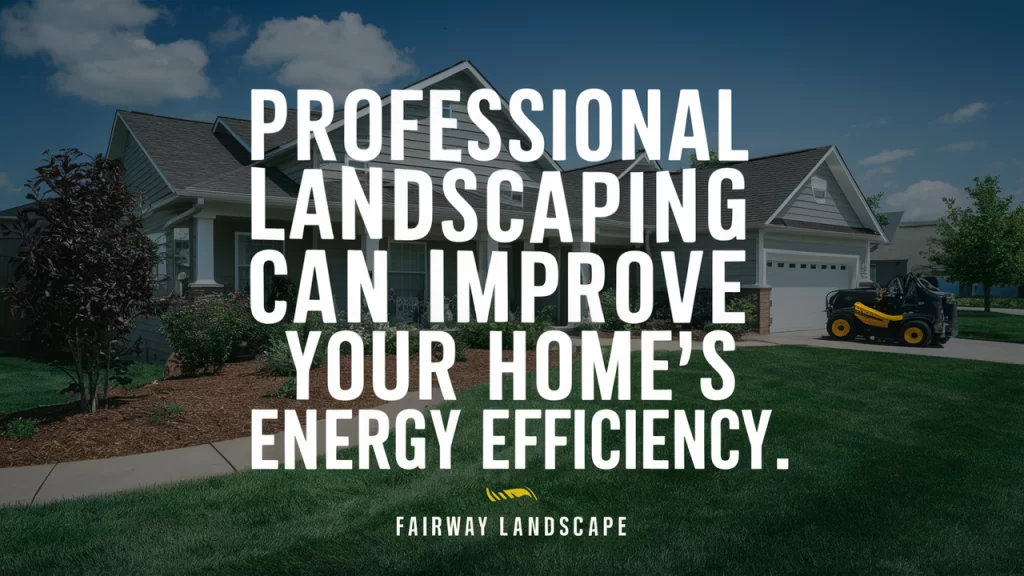When most people think of landscaping, they often focus on the aesthetic benefits it provides. However, did you know that strategic landscaping can also significantly improve your home’s energy efficiency? By working with a professional landscaper, you can reduce your energy consumption and costs while creating a beautiful and environmentally friendly outdoor space. This article will explore the various ways in which professional landscaping can enhance your home’s energy efficiency, from strategic tree planting and windbreaks to green roofs, water management systems, and reflective surfaces.

Section 1: Strategic Tree Planting
Reduce Energy Costs with Strategic Tree Planting
One of the most effective ways to improve your home’s energy efficiency through landscaping is by strategically planting trees. According to both Lethbridge Landscape Supply and Martin John Company, properly placed trees can reduce air conditioning costs by up to 50%. By providing shade and cooling the air through transpiration, trees can significantly lower the temperature around your home, reducing the need for air conditioning during the hot summer months.
When planting trees for energy efficiency, it’s essential to consider factors such as the tree species, mature size, and placement relative to your home. For more information on tree planting for energy efficiency, read our previous blog post: 5 Tips for Planting Trees to Reduce Energy Costs.
Section 2: Creating Windbreaks
Protect Your Home with Windbreaks
In addition to providing shade, trees and shrubs can also be used to create windbreaks that protect your home from cold winds during the winter months. According to both Lethbridge Landscape Supply and Martin John Company, windbreaks can reduce heating costs by up to 25%. By planting a row of evergreen trees or tall shrubs on the north and west sides of your property, you can create a natural barrier that slows down cold winds and reduces heat loss from your home.
When designing a windbreak, it’s important to consider factors such as the height, density, and spacing of the plants to ensure maximum effectiveness. Fairway Landscape offers professional landscape design services for energy efficiency to help you create a custom windbreak solution tailored to your home’s needs.
Section 3: Green Roofs and Walls
Insulate Your Home with Green Roofs and Walls
Green roofs and living walls are innovative landscaping features that can significantly improve your home’s insulation and energy efficiency. According to Lethbridge Landscape Supply, green roofs can reduce cooling needs by up to 75% during the summer months. By covering your roof or walls with a layer of vegetation, you can create a natural barrier that absorbs heat, reduces heat transfer, and improves air quality.
In addition to their energy-saving benefits, green roofs and walls also offer a range of environmental advantages, such as reducing stormwater runoff, improving biodiversity, and mitigating the urban heat island effect. To learn more about sustainable landscaping practices, check out our previous blog post: 10 Sustainable Landscaping Ideas for an Eco-Friendly Yard.
Section 4: Water Management Systems
Conserve Water with Professional Landscaping
Efficient water management is another key aspect of energy-efficient landscaping. By reducing water consumption, you can lower the energy needed to pump, treat, and distribute water to your outdoor space. According to Martin John Company, smart irrigation systems can reduce water usage by up to 30%. These systems use sensors, weather data, and advanced scheduling to deliver the right amount of water to your plants at the optimal times, minimizing waste and ensuring a healthy landscape.
In addition to smart irrigation systems, professional landscapers can also help you incorporate other water-saving features, such as drought-tolerant plants, rainwater harvesting systems, and efficient drip irrigation. Fairway Landscape offers professional irrigation system design and installation services to help you create a water-wise landscape that conserves resources and reduces energy consumption.
Section 5: Reflective and Permeable Surfaces
Use Reflective and Permeable Materials to Control Temperature
The materials used in your landscape can also play a significant role in improving your home’s energy efficiency. According to Lethbridge Landscape Supply, reflective surfaces can reduce surrounding temperatures by up to 10°F. By using light-colored, reflective materials for your patio, walkways, and driveway, you can help reflect sunlight and heat away from your home, reducing the need for air conditioning.
Permeable surfaces, such as permeable pavers or porous asphalt, can also help improve your home’s energy efficiency by allowing water to infiltrate the ground, reducing stormwater runoff and the urban heat island effect. To learn more about sustainable hardscaping options, read our previous blog post: 5 Sustainable Hardscaping Materials for an Eco-Friendly Landscape.
Conclusion
Professional landscaping offers a wide range of opportunities to improve your home’s energy efficiency, from strategic tree planting and windbreaks to green roofs, water management systems, and reflective surfaces. By working with an experienced landscaper, you can create a beautiful and sustainable outdoor space that not only enhances your home’s curb appeal but also helps you save energy and reduce your environmental impact.
If you’re ready to transform your landscape into an energy-efficient oasis, contact Fairway Landscape today at (443) 206-0221 or visit our contact page to schedule a consultation with our team of landscaping experts. We’ll work with you to design and implement a custom landscaping solution that maximizes your home’s energy efficiency while creating a stunning outdoor living space you can enjoy for years to come.
